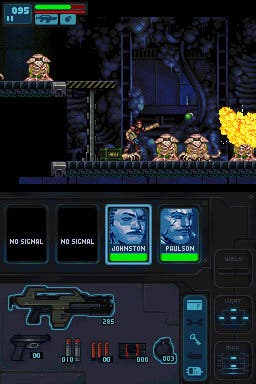Aliens: Infestation
In space, no one can hear dual screen.
Potential replacements are scattered across the labyrinthine levels, but it's a finite supply, and many marines require a lengthy trek through alien-infested crawlspaces and corridors to reach. Weapon upgrades, frequently tucked away in the furthest reaches of the map, also encourage thorough exploration. Spot a hatch just begging to be blown open with a grenade and several minutes later, you might have a more powerful flamethrower.
Yet Wayforward understands that reward must go hand-in-hand with risk, with such wanderings leaving you further from both your destination and any save points. Respawning enemies, so often an irritation, are an essential part of Infestation's design: a reminder that, no matter where you are, you can't afford to get complacent.
The efficiency of the design is reflected in the thrifty reuse of assets: repeat visits to the Sulaco with fresh tools gradually open up more of this intricate maze. Yet if some of the environments feel a little samey, the attention to detail is remarkable.
There's a demonstrable love for the lore - Giger's space jockey pops up in the background, as does the derelict alien ship on LV-426. Beat the second boss and you'll unlock a neat mini-game based on Bishop's knife trick. And yes, there's a fight between a queen and a marine in a power-loader. All this is brought to life with some splendid sprite work; it's the kind of game we kid ourselves all 16-bit games used to look like, and WayForward indulges our blind nostalgia accordingly.

There are a few concessions to accessibility, like flares with which you can mark useful locations, ammo boxes, first-aid kits, or survivors who won't join your team until you're a man down. Elsewhere, there are elements of survival horror in the design, the scarcity of ammunition and the addition of a stamina meter often leading to desperate battles as you fend off aliens with a feeble pistol while hoping you've got enough energy to sprint to safety. You can even weld doors shut to prevent aliens from chasing you through the ship, leading to moments of heart-stopping tension as you thumb the touch screen to seal off your pursuer just before it bursts through.
Encounters with human enemies are less agreeable, puncturing the flow with dull and repetitive stop-and-pop shooting as you crouch behind crates waiting for them to stand before blind-firing into their faces. You'll need to repeat this at least twice before they drop, and usually two or three times within the same room: a drawn-out process that makes the backtracking and respawning more frustrating. There's also a particularly egregious example of poor checkpointing in the early game.
But fans of Scott and Cameron's fiction will be delighted to see this iconic universe recreated in miniature, while anyone hankering after a 2D Metroid (let's face it, we're not likely to get one from Nintendo any time soon) will be equally satisfied. It seems that, in keeping Death so busy, WayForward has ensured the DS will avoid his scythe a little while longer.

